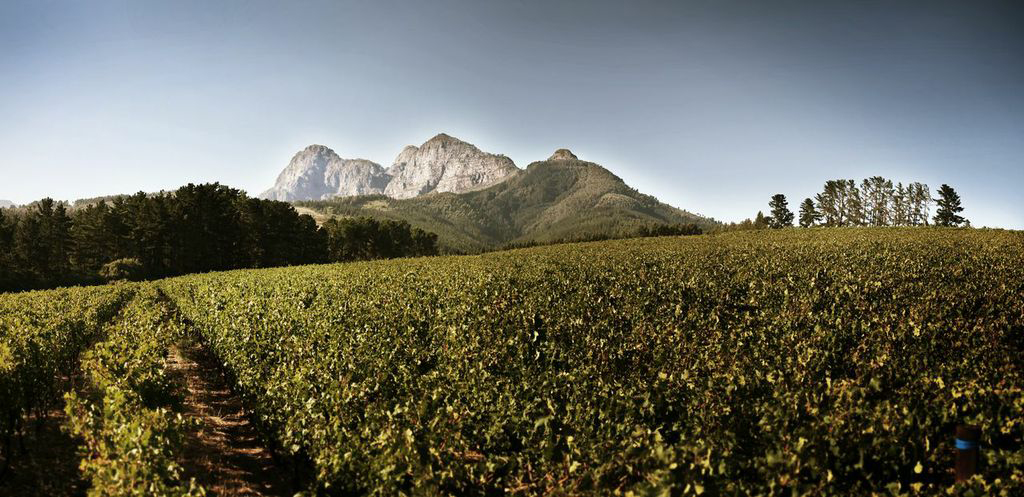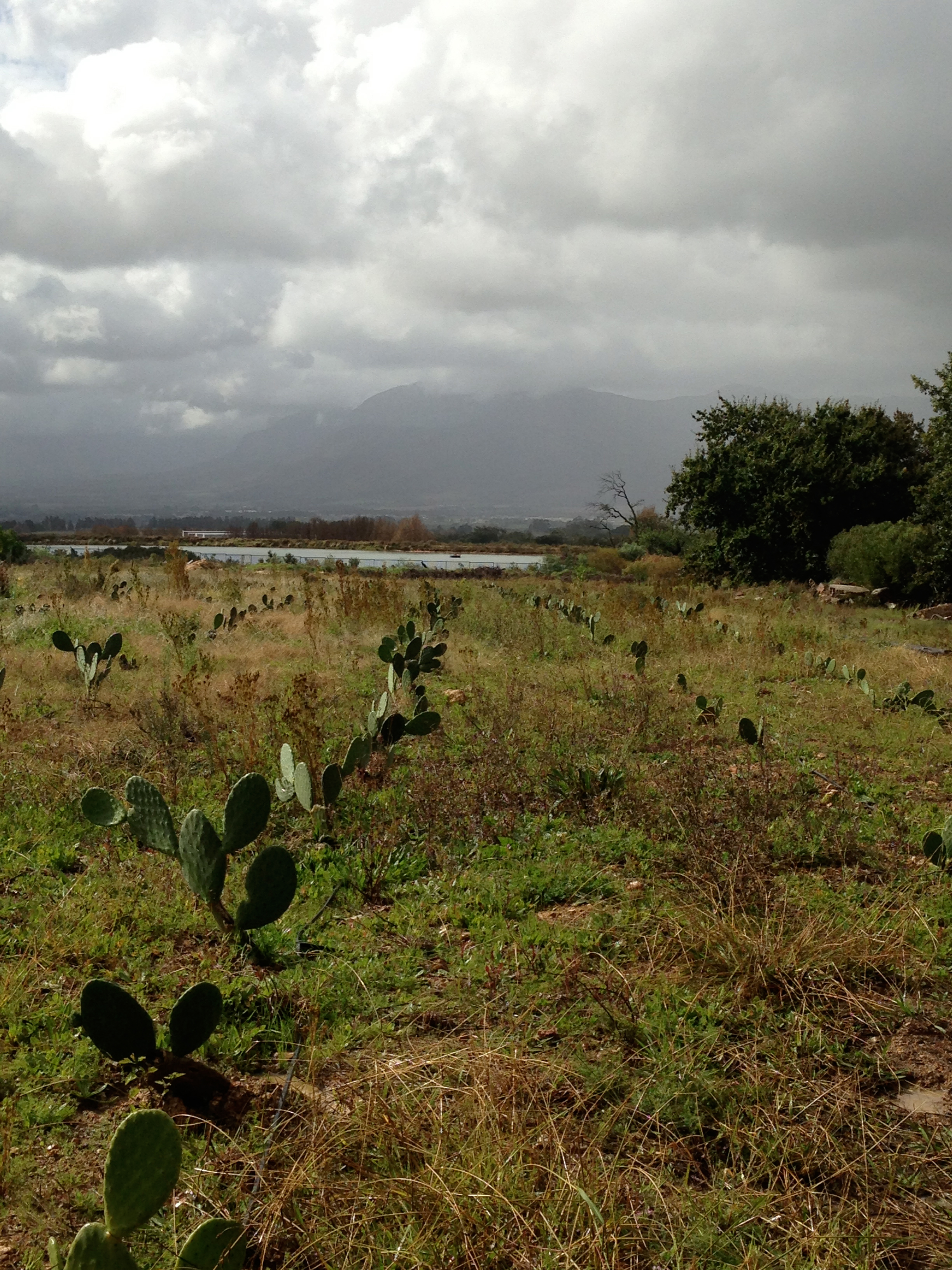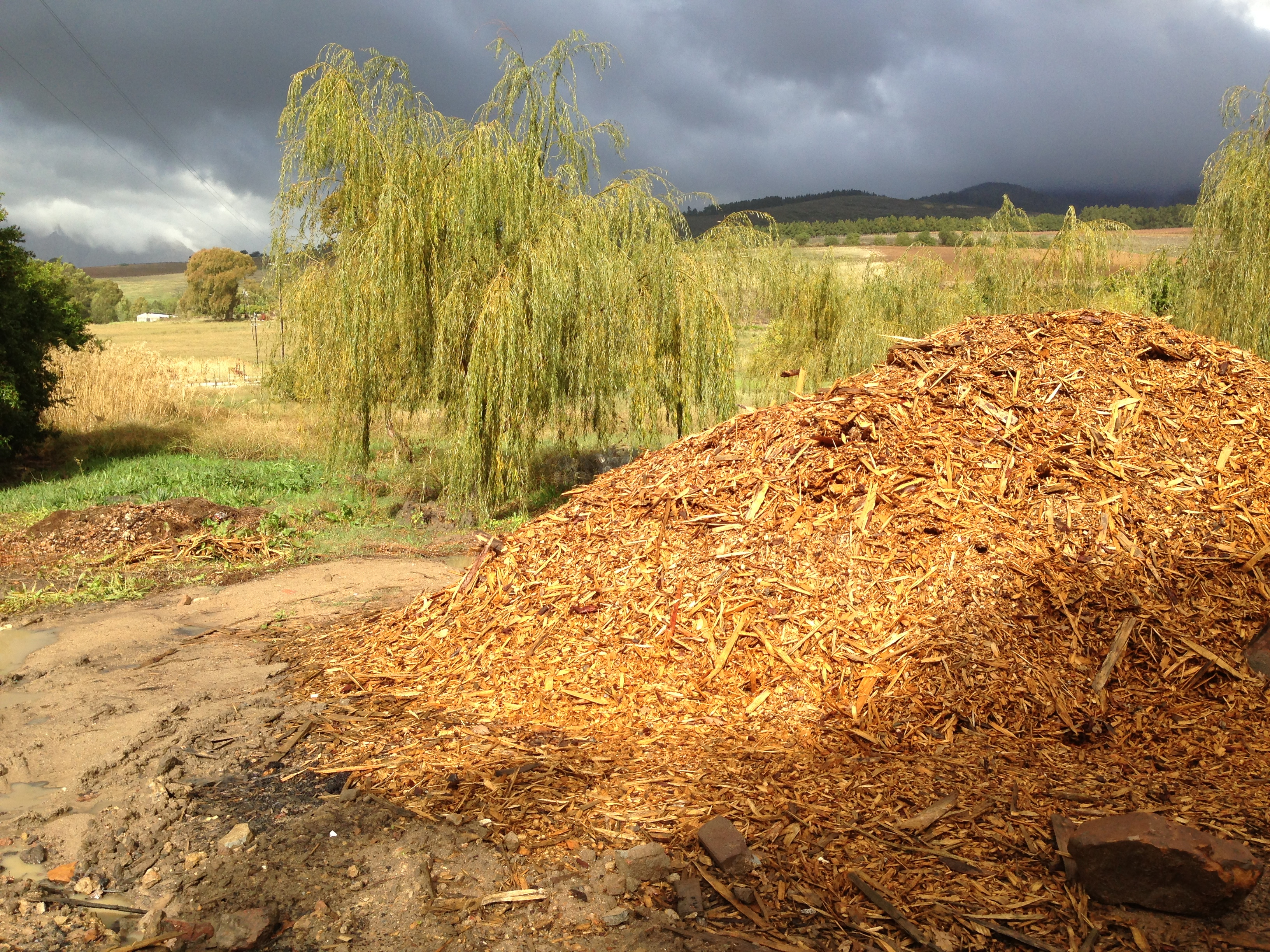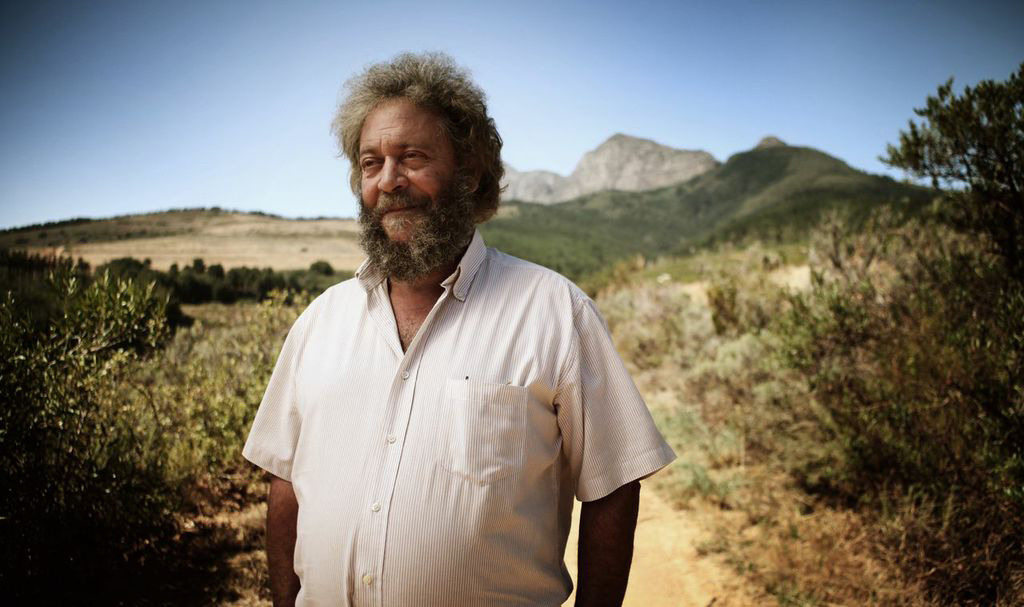Winery Adapting to Climate Change
Air Date: Week of June 14, 2013

The entrance sign at Backsberg Estate Cellars. (Photo: Jennifer Stevens-Curwood)
A new report suggests that by the year 2050 as much as half of South Africa’s wine growing region will no longer be able to grow grapes as a result of climate change. Living on Earth host Steve Curwood visited Backsberg Estate Cellars, South Africa’s first carbon neutral vineyard to see how it is already adapting and implementing creative solutions to reduce its contribution to greenhouse gas emissions.
Transcript
CURWOOD: It's Living On Earth, I'm Steve Curwood. The National Academy of Science says that thanks to climate change, there will be dramatic shifts in where wine grapes grow over the next 40 years. And that could mean more wine from, say, Missoula, Montana and Surrey, England. But researchers also predict a reduction of 50 percent in land suitable for wine in many places, including the Napa and Sonoma valleys in California, Bordeaux and the Rhone Valley in France, Tuscany, in Italy and South Africa.
With the end of apartheid 20 years ago, the Cape region of South Africa put its people and its Mediterranean climate to work and built a billion bottle a year wine industry that now exports eight times as much as it did just a dozen years ago. And South African wine makers are taking the climate threat seriously, with associations offering advice on how wineries can both mitigate and adapt to climate risks by becoming more sustainable, managing water and lowering carbon footprints.
[HEAVY RAINFALL]
CURWOOD: It’s raining on and off on a winter day in May when I stop by the Backsberg Estate Cellars. The wine farm lies on the lower reaches of Simonsberg Mountain near Paarl and Stellenbosch, a 40-minute drive from Cape Town. In 2011, Greenpeace gave Backsberg an award for Climate Change leadership, after it became the first winery in Africa to go carbon neutral. It’s a matter of pride for Simon Back, a young man with bright inquisitive eyes and an easy manner, who manages marketing and exports for the vineyard. He says the weather already seems less stable.

Simon Back (Photo: Backsberg Estate Cellars)
BACK: We’re at the end of May now and May was a relatively dry month so it feels like all the rain is coming in the space of a couple of days. There’s a huge amount of rain that’s come in the last 48 hours and there’s more to come in the next few days.
CURWOOD: So more weather volatility, that’s what you’re seeing.

The vineyards of South Africa’s Backsberg Estate Cellars. (Photo: Backsberg Estate Cellars)
BACK: It would appear so on the surface, definitely. I can’t really claim, at least in the short time that I’ve been working at the farm, that I can say definitively that there has been a rise in temperatures but I can definitely see a changing in weather patterns. So for instance this year, the harvest was almost two, three weeks later than usual. Normally in the past we could more or less pinpoint to the day exactly when we were going to harvest a particular block.
CURWOOD: And there is a long record to compare today's timing against. As the rain takes a break, we settle in for a chat on the veranda of the winery restaurant where Simon Back tells me this land has been in his family for four generations, since his great-grandfather emigrated from Lithuania.
BACK: My family is Jewish and they were fleeing some of the interesting stuff going on in Europe at that time. He got on a boat and arrived in Cape Town in 1902 and a few long years of lots of work and probably some tears along the way, but he managed to own a butchery in a nearby town called Paarl. He worked at the butchery for a few years. In 1916, someone came into the butchery and said, “Hey, do you want to buy a farm?” He saw it as an opportunity. He sold his butchery and bought what is today Backsberg.
CURWOOD: So, this wine farm has been here for nearly 100 years and I gather you’d like it to be here for another 100 years at least.
BACK: Exactly, I’m the fourth generation and hopefully there will be many more after me.
CURWOOD: There’s a challenge though. This recent paper from the National Academy of Sciences says the area that South Africa is going to be able to grow grapes for wine is going to shrink by half over the next 30 or 40 years. What does that mean for you here?
BACK: I think climate change is very much a reality and a challenge that the South African wine industry is going to have to face and come up with ways of managing over the next few years.
CURWOOD: So, when you come into your estate there’s a big sign that says South Africa’s first carbon neutral vineyard. What does that mean?
BACK: In 2006, mostly my father but really the rest of the company, really sat down and said, “What are we responsible for as a winery and as a business? What is our impact on the environment?” We as a family and as a business have enjoyed the fruits of the land for many years. It was this feeling that we now need to A, take account and B, reverse the clock on some of the impacts that we’ve had. What we’ve really tried to do here is produce great wine, which is something we are not willing to compromise on but do it slightly differently and really look at what we are doing and making reductions in the emissions, reduce our impact on a day to day basis.
CURWOOD: OK, so let’s walk around and you can show us some of these things that you’ve been talking about.
[WALKING]
BACK: Should we talk a little about what’s going on in the restaurant?
CURWOOD: Sure.
[RESTAURANT ATMOSPHERE]

The restaurant at the Backsberg estate. (Photo: Jennifer Stevens-Curwood)
BACK: If you look at the furniture and roof within the restaurant we’ve tried to give a kind of second life to our oak barrels. The wine industry is effectively cutting down trees in France that are perhaps 300 years old. We’re turning it into a barrel; we’re using the barrel for between five and seven years and then effectively it’s a waste product. What we’ve tried to do here at Backsberg is make furniture out of it. We’ve got tables, we’ve got chairs and our roof is covered with oak staves.
CURWOOD: Well, you have a full restaurant now; are you selling this furniture elsewhere now?
BACK: Yeah, we’ve got a full-time carpenter who makes a lot of this furniture and we’re trying to sell it as well.
CURWOOD: He then leads the way into what seems to be a mostly empty warehouse, scented with fresh wine.
[CELLAR ECHO]
BACK: So now we’re kind of in the heart of the cellar and this is where, over harvest time, it’s a very busy area where the fermentation happens and the pressing of the grapes happen. So if you look within a cellar there’s a massive demand for electricity and that electricity is primarily used for refrigeration and controlling the fermentation.
CURWOOD: And the electricity is used to cool and pump and…?
BACK: Exactly so; in the case of red wine we want to control the fermentation in degrees Celsius at around between 27 and 29, and in white wine around 11, 12, 13.
CURWOOD: The way you’re supposed to drink it.
BACK: Exactly. [LAUGHS] So the things that we’ve done here is that we’ve tried to sort of manage the electricity usage here. And in the case of red wine we’ve figured out that, and again this is not really so much a technological advancement as much as it is just using some of the information out there. We’ve got a large irrigation dam just up the hill here and we realized that water beneath a certain depth was a constant 15 degrees and as I said with the red wine fermentation, that has to happen at 27 degrees and so we realized we could actually just use dam water below that level in managing the fermentation. And so with all our red wine now we’re hardly using any electricity to control the fermentation. In the case of white wine we couldn’t use the dam water because the fermentation happens at a temperature below that of the dam water, but we can use that initial cooling and just supplement that to control the white wine fermentation.
CURWOOD: Not only do they save on cooling costs in the summer heat, no pumps are needed to drain the fermentation vats as they are mounted on a balcony where the wine can be fed by gravity into the barrels. Simon estimates the vineyard has cut its electricity consumption by 20 to 25 percent by harvesting the low hanging fruit of efficiency. And for the bulk of remaining energy needs they’re using biofuels.
[WASHING OAK BARRELS]
CURWOOD: A biomass boiler makes hot water for all kinds of applications, including the cleaning of the oak barrels used to age the wine.
[WATER BLASTING]
CURWOOD: The fuel for the biomass boiler is free.
BACK: Right now we have a partnership with a sawmill down the road and we’re using a lot of their waste cuttings and sawdust, which we’re feeding our biomass boiler with.
[BIRDS CHIRPING OUTDOORS]
CURWOOD: But just in case the sawmill stops giving away its waste cuttings, Backsberg wants to be prepared.
BACK: So, we are looking at all sorts of ways of actually growing our own biomass here on the farm itself. And to that point, if you look over the field here what you see growing there is actually prickly pears. And that is a potentially huge source of biomass that we can potentially dry and feed our biomass boiler with. And one of the fantastic things about this plant is that it’s very hardy and doesn’t require a lot of water.

The Back family hopes prickly pear cactus will be a source of biofuels for them in the future. (Photo: Jennifer Stevens-Curwood)
[WALKING]
CURWOOD: What about putting, say, solar panels here or windmills?
BACK: Both of those, solar and wind, are becoming very interesting. Up until recently, solar has just been too expensive but the last couple years, even the last year, the prices have come down dramatically and there’s even now a rebate that’s available so we are seriously looking at putting in some solar to add into the mix of what we’re doing.

Wood scraps from a nearby lumberyard serve as a source of fuel for the vineyard today. (Photo: Jennifer Stevens-Curwood)
CURWOOD: And windmills?
BACK: Unfortunately, we don’t have sufficient wind over the whole duration of the year to make it a viable proposition so unfortunately, wind isn’t going to work for us at this stage.
CURWOOD: But you do have plenty of sunshine.
BACK: We do have plenty of sunshine, and us on the farm, and South Africa in general is a huge resource as far as that goes. The other thing we’ve done as far as offsetting emissions part is where ever we…on small parts of the farm where it doesn’t make sense to grow vines, we planted trees. Here before you you can see an array of trees which is part of offsetting our carbon emissions. If you drive around the farm you’ll see little pockets of trees everywhere.
[CAR DRIVES BY]
CURWOOD: And Backsberg also sponsors the planting of trees elsewhere in South Africa to make sure they have offset all their carbon emissions. This vineyard constantly looks for ways to become more sustainable. They’ve planted acres of blueberries to diversify their crops, and they have a gleaming tower of tanks devoted to an experiment of making biodiesel. They’ve also expanded their water reservoirs, as well as reusing their gray water. And under what looks like a large greenhouse frame, they are working to turn their waste cardboard cartons into an asset.
BACK: So, right here where we are standing now, you can see the beginning stages of a project which involves farming with earthworms. We’ve got a lot of waste carton from the winery, which we are trying to get rid of and worms really love to eat the carton. Basically, what happens is on the one hand we’re getting rid of the carton and two we’re having some amazing compost as well. And the other thing is that you can actually harvest the worms and mash them up and dry them and get protein. And with the protein you can do a number of things as well, in terms of actually just selling it in the form of protein.

Worms turn cardboard waste into rich fertilizer. (Photo: Jennifer Stevens-Curwood)
CURWOOD: Who would buy worm protein?
BACK: A lot of fish farmers would use protein and so that’s going to be one of the shortages in the world going forwards, if you look at how our seas are being overfished. There’s going to be a big shortage on the protein front I think.
CURWOOD: So, you apply the compost as fertilizer to your vines?
BACK: Exactly, so we’ll take the compost from this and put it back into the vineyards and that will hopefully contribute to having healthier vines.
[DIESEL ENGINE]
CURWOOD: So, where are we off to now?
BACK: I’m going to take you on a tour of the farm and specifically show you the lyre trellising system that we put in place as well. We are starting to roll it out over the farm when we plant new vineyards.

The lyre trellising system at Backsberg Estate Cellars. (Photo: Jennifer Stevens-Curwood)
[HAND BREAK]
BACK: Shall I turn the car off?
CURWOOD: Yeah, we’ll get out for a moment.

Simon Back shows Steve Curwood the lyre trellising system. (Photo: Jennifer Stevens-Curwood)
[DOORS OPEN, WALKING]
CURWOOD: So, what are we looking at here now?
BACK: So, this is a block of sauvignon blanc that we are looking at and the interesting thing that I want to point out is that it’s quite a different trellising technique to your standard vertical straight line planting system. What you’ve got here is the lyre system, basically you plant them closer together but then you train them left and right up into a kind of Y shape and what you have here is kind of a double hedge so the widths of the rows are wider so you are driving up and down per hectare effectively less but you’ve got more or less the same vineyard canopy space. It’s a real win because you’re saving on irrigation pipe, you’re saving on wire, you’re saving on polls, and you’re driving in the vineyard less.
CURWOOD: Can we walk up just a little bit?
BACK: Sure.
[WALKING]
BACK: If you look at the slope there across the way there’s nothing planted to vine there and this section of the farm going down into the valley is an area we’ve set aside for the preservation of the fynbos, which is the kind of natural vegetation of the area. We are part of a program run by the WWF called the biodiversity and wine initiative as part of that we’ve set aside 10 percent of our land holding for the preservation of fynbos. And within that program we are a so-called champion of biodiversity. I think there are 20 wineries or so in South Africa that have gotten that status.
CURWOOD: So what creatures are here because you’ve set aside this land?
BACK: The great thing is that we’ve seen an incredible increase in bird life. For instance, every year we have a bird club come and visit and document all the bird life on the farm and we’ve seen a number of different birds come back to this area...and small buck. It’s been really amazing to see a kind of rejuvenation of the area.
CURWOOD: And this is no small matter. Without conservation reserves, mature producing vineyards offer poor habitat value for native species.
[WINE TASTING ROOM]
CURWOOD: Just before our final stop on the tour - the wine tasting room - we meet Michael Back, Simon’s father. Michael is the third generation of Backs to grow grapes on this land and the driving force behind the innovations Simon showed me.

Michael Back (Photo: Backsberg Estate Cellars)
M. BACK: I’m the chief cook and bottle washer. So, I’ll sign the checks or I’ll shovel the you know what. [LAUGHS]
CURWOOD: Why did you decide to try to make your vineyard climate neutral?
M. BACK: I think it comes from a long way back. If you’re in the agricultural sector you have access to big equipment so when a big tree is in your way you don’t need to work around it. You just push it out of the way. One day, 15 or more years ago, I was driving around the farm and I thought, hang on, we’ve actually done a lot of damage to the property and we need to start to slowly rebuild it back. That’s when the penny dropped that you can farm, you can be commercial, but you can be concerned about the environment at the same time.
CURWOOD: We head into the wine tasting room, complete with oak barrel furniture, the Backsberg Estate Cellars' whole suite of over two dozen fine wines, including some special reserves and several gold medal winners. Along one wall there’s a group of wines that’s been a real hit with the hiking and biking crowd in South Africa, called Tread Lightly.
BACK: It’s a range of wines that’s in fact bottled in PET, so plastic, if you will. Wine connoisseurs might be shocked at this notion but in fact there are many benefits to bottling a wine in PET. First of all, the bottle itself weighs about 50 grams, which if you compare to a glass bottle weighs 450 to 500 grams. You’re talking about a tenth of the weight. Imagine how this gets multiplied out through the supply chain. The shipping of the bottles to the winery and us exporting the wine around the world - there’s massive savings as far as fuel and emissions go.
CURWOOD: So what about the quality of wine in these plastic bottles?
BACK: The wine is really good quality. In fact a number of the wines have picked up some awards, so that’s great news. I think the only thing you have to be aware of is that wines in PET generally at this point in time are not going to keep for more than two years. So, if you’re intending on cellaring wines for 10 to 20 years, then it’s not something you maybe want to do in the case of PET.
CURWOOD: So, you better drink it right up.
BACK: Yeah, you better drink it right up, which I know in my case is not a major problem!
[LAUGHS]
[BIRDS CHIRPING OUTDOORS]

Tread Lightly is the Backsberg wine sold in plastic bottles. It’s reportedly been a hit with hikers and bikers. (Photo: Jennifer Stevens Curwood)
CURWOOD: And from what I tasted with Simon Back at the Backsberg Estate Cellars it wouldn’t be a problem for me either. Backsberg and other sustainable wine estates are being closely watched for clues as to how well the growers of this finicky crop can cope with the increasingly volatile climate with extremes of heat, drought and rainfall. And who knows? While there may be some territory that simply becomes totally unsuitable for wine production, good management may allow vineyards like Backsberg to continue to succeed, and serve up plenty of fine and delicious vintages to enjoy in the years to come.
Links
"Climate Change, Wine and Conservation " in the Proceedings of National Academy of Sciences
Living on Earth wants to hear from you!
Living on Earth
62 Calef Highway, Suite 212
Lee, NH 03861
Telephone: 617-287-4121
E-mail: comments@loe.org
Newsletter [Click here]
Donate to Living on Earth!
Living on Earth is an independent media program and relies entirely on contributions from listeners and institutions supporting public service. Please donate now to preserve an independent environmental voice.
NewsletterLiving on Earth offers a weekly delivery of the show's rundown to your mailbox. Sign up for our newsletter today!
 Sailors For The Sea: Be the change you want to sea.
Sailors For The Sea: Be the change you want to sea.
 The Grantham Foundation for the Protection of the Environment: Committed to protecting and improving the health of the global environment.
The Grantham Foundation for the Protection of the Environment: Committed to protecting and improving the health of the global environment.
 Contribute to Living on Earth and receive, as our gift to you, an archival print of one of Mark Seth Lender's extraordinary wildlife photographs. Follow the link to see Mark's current collection of photographs.
Contribute to Living on Earth and receive, as our gift to you, an archival print of one of Mark Seth Lender's extraordinary wildlife photographs. Follow the link to see Mark's current collection of photographs.
 Buy a signed copy of Mark Seth Lender's book Smeagull the Seagull & support Living on Earth
Buy a signed copy of Mark Seth Lender's book Smeagull the Seagull & support Living on Earth

